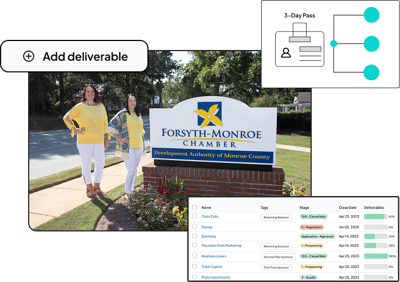Planning an event is exciting, but securing sponsors can make all the difference in your budget and...
Event sponsor trends: What brands want in 2025
Table of contents
- The changing sponsorship landscape
- Authenticity over advertising
- Data-driven partnerships
- Sustainability and social impact
- Digital integration and hybrid experiences
- Micro-influencer and community partnerships
- Year-round brand relationships
The world of event sponsorships continues to evolve, driven by digital engagement, data-focused solutions, and a growing commitment to social impact. Brands and event sponsors in 2025 aren’t just looking for their logo on event materials—they want tailored sponsorship opportunities that generate authentic connections and measurable value. Understanding these trends is essential for event organizers striving to secure quality partnerships and stand out as industry leaders.
Recent data from Event Academy highlights the critical role sponsorship plays in event success, while Bizzabo’s annual reports provide a window into sponsorship opportunities, budget shifts, and the impact of hybrid event experiences. Let’s dive into what matters most right now.
The changing sponsorship landscape
Sponsorship and partnership revenue is front and center for event organizers. According to Event Academy, 88.4% of event marketers say that sponsorships and partnerships are the most effective drivers of event revenue—far outpacing audience engagement and other revenue streams.
Likewise, sponsorship success is a leading indicator for event outcomes:
- 31.8% of event marketers judge their event’s success primarily by the sponsorships they secure
- In 2024, securing sponsorship was named the biggest event marketing challenge by 24.6% of organizers—the top challenge ahead of engagement and content creation concerns.
These numbers showcase the clear demand for strong sponsorship programs and the need for solid sponsorship proposal strategies. For event sponsorships in 2025, event organizers are focusing on:
- Demonstrating clear value to sponsors
- Prioritizing audience alignment
- Building programs that enhance brand awareness and support event financial goals
Authenticity over advertising
One of the top sponsorship trends for 2025 is the move toward authenticity. The days of generic banners and passive logo displays are fading. Instead, event sponsors want to be part of real experiences, contributing products or services that enhance the event for everyone.
What brands expect from authentic sponsorship opportunities:
- Genuine involvement with event attendees (think demo booths, interactive workshops, or behind-the-scenes tours)
- Co-created activities with influencers or community leaders
- Brand activations that are woven into the event atmosphere, not just presented as advertisements
- Integration with the event’s mission, values, and overall story
Music festivals demonstrate this shift especially well; beverage sponsors no longer just hand out samples—they build experience zones that offer value through education, entertainment, and community building.
To attract sponsors in 2025, make sure your sponsorship opportunities include ways for brands to provide meaningful services or experiences, and build these goals into your sponsorship proposal and event materials from the start. Learn more about ways to grow your event here.
Data-driven partnerships
Event sponsors today expect detailed data on how their participation performed. Sponsorship packages that include clear metrics for engagement, brand awareness, and social impact are much more likely to unlock financial support and repeat deals.
Data points event sponsors seek:
- Demographic breakdowns of event attendees
- Quality of contacts collected (for example, through lead-capture at demo stations)
- Metrics from live streaming, app engagement, or social media
- Post-event surveys assessing sponsor impact and attendee brand recall
A recent report shows that around 12% of a brand's budget goes to sponsorships. As you plan your sponsorship program, invest in event technology—such as mobile apps or customer relationship management tools—that collects and presents the data industry leaders now expect. Eventeny has a feature that allows you to track your sponsors, deliverables, and more.
Including these insights in your sponsorship packages not only helps you secure more sponsors—it also justifies higher pricing and strengthens long-term sponsorship opportunities. Tracking these metrics is especially important for hybrid events, where digital and in-person channels blend together.
Sustainability and social impact
Sustainability and social impact are at the forefront of event sponsorship trends. Brands want to see that your event focuses on sustainability, shares their corporate social responsibility values, and delivers visible benefits to local communities.
Ways to showcase sustainability and social impact in your sponsorship proposal:
- Highlight zero-waste and recycling initiatives
- Show partnerships with local suppliers or nonprofits
- Detail scholarship or grant programs for community groups
- Highlight volunteer opportunities for sponsors' staff members
When you demonstrate tangible results—like waste reduction metrics or photos from community volunteering events—you make your sponsorship program more appealing. These elements can help event organizers attract sponsors who want to be publicly aligned with positive change.
For further engagement, consider invite-only initiatives where sponsors and their employees volunteer at your event, or use double the donation campaigns to match contributions and multiply social impact.
Digital integration and hybrid experiences
Hybrid events and technology-driven engagement will continue to define the event sponsorship landscape. Event sponsors are increasingly interested in digital sponsorship opportunities, such as live streaming, branded sessions within event apps, or online networking lounges.
Valuable digital touchpoints for event sponsors:
- Sponsor-branded content in mobile apps or live streaming sessions
- Virtual booths for product demos or video chats
- Gamification elements—like QR scavenger hunts—that capture attendee data
- Integrated social media campaigns that deliver ongoing brand awareness
A Bizzabo study found that hybrid events produce 35% more qualified leads than purely physical ones. This makes hybrid event strategies essential parts of any sponsorship packages, especially for organizations looking to provide sponsorship opportunities that span both in-person and virtual formats.
When creating your sponsorship program, consider offering combined digital and physical activations, and use tools to measure attendee interaction at every step.
Micro-influencer and community partnerships
Connecting with local communities and micro-influencers is another event sponsorship trend on the rise. Brands are investing in sponsorship opportunities that allow them to build authentic relationships with smaller, highly engaged groups.
Community-centric sponsorship strategies:
- Pair event sponsors with local businesses or micro-influencers to co-host sessions
- Create skills workshops or mentorship programs driven by sponsors’ staff members
- Enable product or service trials for local audiences, gathering feedback and testimonials
- Shine a spotlight on brands that support your event's mission and values, strengthening the community connection
Event sponsors value deeper connections, especially when sponsorship packages offer opportunities to support local causes or highlight community leaders.
Year-round brand relationships
Gone are the days of one-off event sponsorships. The most successful event organizers are building ongoing, year-round sponsorship programs that keep brands involved through multiple touchpoints—blogs, collaborative content, and community initiatives. Many organizers are also securing multi-year sponsorship contracts, which provide financial stability, reduce the need for constant prospecting, and give brands confidence that their investment will grow with your audience over time.
Best practices for year-round sponsorship success:
-
Develop a sponsorship program that includes quarterly strategy check-ins with sponsors
-
Expand sponsorship packages to cover digital content, educational workshops, or local service projects
-
Create event materials and post-event reports that demonstrate impact and share stories year-round
-
Build advisory groups so sponsors can help shape your event’s direction and support
Multi-year deals also open the door for co-created campaigns, consistent reporting, and relationships that evolve beyond a single event cycle. Event Marketer reports that sponsors with ongoing partnerships show 89% higher satisfaction rates and are much more likely to provide long-term financial support.
Securing your sponsorship future
Event sponsorship trends in 2025 center on authentic engagement, measurable impact, and lasting community relationships. By offering sponsorship packages that prioritize data and value, focusing on sustainability, and developing your sponsorship proposal around what brand partners truly want, you'll be well-positioned to attract sponsors and secure financial support for your events.
Remember to align your event materials and sponsorship program with key goals—engagement, innovation, and social impact. For even more guidance on attracting sponsors, crafting compelling sponsorship opportunities, and staying ahead in this dynamic field, explore our resources at resources.eventeny.com/blogs.
By understanding where the industry is headed, you’ll be ready to secure top event sponsors, build trust with local communities, and create events that inspire, connect, and make a difference—all while driving your sponsorship program’s long-term success.
Enjoy what you're reading? Subscribe here to get more insights, industry news, and more!




